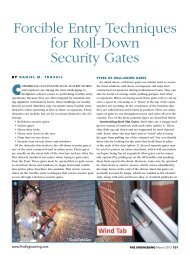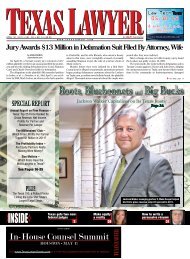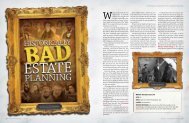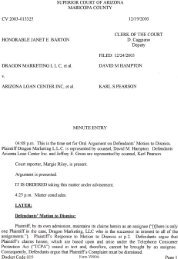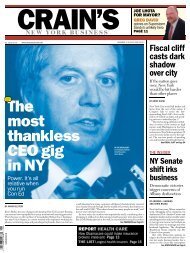A Burden - American Business Media
A Burden - American Business Media
A Burden - American Business Media
Create successful ePaper yourself
Turn your PDF publications into a flip-book with our unique Google optimized e-Paper software.
HEAVY<br />
<<br />
A <strong>Burden</strong><br />
A remnant of a simpler time, the generous<br />
pension plans at many Am Law 100 firms place<br />
an increasing weight on younger partners.<br />
Is a generational battle looming<br />
By Julie Triedman<br />
P h o t o g r a p h By Fr e d r i k Br o d e n<br />
photo credit feet in<br />
It’s a safe betthat<br />
partners at Simpson Thacher & Bartlett aren’t lying awake<br />
at night worrying about their 401(k)s. No matter what happens to the stock market, they’re guaranteed<br />
to retire rich, thanks to the firm’s pension plan.<br />
The plan—the most generous among 21 Am Law 100 pension plans we analyzed for this article—promises<br />
retired partners a quarter of the compensation they received during their highestearning<br />
years. For life. On top of that, retirees receive an additional payout of 130 percent of<br />
that highest-compensation average, spread out over seven years. Currently, 30 retired Simpson<br />
partners are receiving these pension benefits.<br />
Benefits under Simpson’s plan, like those of other Am Law 100 firms with traditional unfunded<br />
pension programs, are paid for out of current income. And because Simpson, like other Am<br />
Law 100 firms, has steadily expanded the size of its partnership since the plan was created, we<br />
wondered how much it will cost the firm over the next decade or so, as a glut of those it elevated<br />
to partner in the seventies and eighties retire.<br />
The answer: a lot. Our hypothetical, back-of-the-envelope calculation of Simpson’s future<br />
liability—which we believe can stand in for at least a dozen similarly situated firms—indicates<br />
that it will be paying out of its annual income a minimum of roughly $65 million a year by 2022,<br />
double the estimated current annual payout. (We asked Simpson chairman Philip “Pete” Ruegger<br />
III to correct or comment on our numbers. He declined.)<br />
A scan of the firm’s 194 partners reveals that approximately a quarter could be expected to<br />
72 May 2009 | americanlawyer.com<br />
The <strong>American</strong> Lawyer | March 2012 73
etire by 2022, providing that most do so around the firm’s<br />
normal retirement age of 62. Assuming a handful die early,<br />
the firm may see 43 new full-freight retirees within the<br />
decade. Assuming that this batch of senior partners have<br />
been earning $3.5 million during their highest-compensated<br />
years—a conservative estimate, consultants say, at a<br />
firm that posted average profits per partner of $2.6 million<br />
in 2010—a soon-to-retire partner can expect roughly<br />
$875,000 a year in benefits, plus roughly $650,000 in each<br />
of the first seven years from the additional distribution<br />
(subtracting roughly $50,000 offset by another defined<br />
benefit plan funded by the firm). Over the decade, the<br />
firm’s annual liability gradually creeps up to roughly $65<br />
million for the new retirees by 2022, not including benefits<br />
for those already in retirement. But as long as the firm<br />
increases its net by about 3–4 percent a year (since 2000,<br />
PPP has grown an average of 4.68 percent annually), the<br />
drag on profits will remain just about what it is now.<br />
At Simpson and many other Am Law 200 firms, pensions<br />
are the elephant in the room. Several firms continue to guarantee<br />
their equity partners far richer pension plans than they<br />
probably should. And that future pension liability is growing<br />
at a time when it is looking less than certain that profits and<br />
partner head count will grow in step with them.<br />
The recession, with its double whammy of retirement<br />
investment portfolio declines and firm revenue slowdowns,<br />
was a broad wake-up call for firms that fund pensions out<br />
of current income, as well as for the broader swath of firms<br />
a pensions primer<br />
The fine print about how firm retirement plans work.<br />
Until 1987, the Internal Revenue Service<br />
didn’t allow firms to put more than<br />
$7,500 per partner into tax-advantaged<br />
pension plans each year. In 2000 and<br />
2002 the IRS sharply increased the<br />
amounts that firms could set aside in<br />
defined benefit programs, and many law<br />
firms adopted the new plans as an alternative<br />
to their then common unfunded<br />
plans. Currently the maximum retiree<br />
benefit permitted under the tax-advantaged<br />
plans is $200,000; it rises yearly<br />
with the cost of living. (Non-tax-advantaged<br />
plans continue to have no benefit<br />
or contribution limits.)<br />
Here is a guide to what many firms<br />
now offer:<br />
Defined benefit plan This is an<br />
umbrella term for any plan where the<br />
annual retirement benefit is determined<br />
by a set formula, including traditional<br />
plans and the newer-generation cash<br />
balance and variable-annuity plans. The<br />
formula establishing the benefit may<br />
incorporate past compensation, years<br />
of employment, age at retirement, and<br />
other factors.<br />
Cash balance plan Sometimes<br />
called a “partner parity” plan, this is<br />
a defined benefit plan that looks like a<br />
bank account. Traditionally, each partner<br />
has a notional retirement account where<br />
interest is credited on the basis of an<br />
external index, such as a Treasury rate.<br />
The firm pays a contribution annually,<br />
charged back to the current partners,<br />
to fund the plan up to a defined target<br />
or level of “pay credit” (usually based on<br />
deferred compensation). If the investment<br />
gains do not meet the external<br />
interest rate returns credited to each<br />
partner’s account, the firm—and indirectly,<br />
the current partners—must make<br />
an additional contribution to top up the<br />
investment pool.<br />
Market-rate cash balance plan<br />
This IRS–approved plan, which is permitted<br />
as of October 2010, allows retirement<br />
annuity levels to fluctuate along<br />
with the actual return on a firm’s investment<br />
portfolio, thus reducing the possibility<br />
of a shortfall. A similar plan that<br />
allows payouts to fluctuate is known as<br />
a “variable annuity.”<br />
—J.T.<br />
that fund benefits out of firm-run investment portfolios.<br />
Many in the latter category had to dig into earnings to<br />
cover shortfalls in guaranteed benefits funded by firm investments.<br />
But the problems created by the sagging economy<br />
brought into relief a bigger, looming issue: The ranks<br />
of retired partners is swelling just as the number of equity<br />
partners—who are ultimately responsible for funding the<br />
pension plans—is leveling off. “This is an issue that cuts<br />
across all regions and all sizes of firms,” says Dan DiPietro,<br />
chair of the Law Firm Group of Citi Private Bank. “It’s a<br />
generational issue: As firms face the bubble of baby-boomer<br />
partner retirement, the problem will only get bigger.”<br />
The firms facing the largest future liability are the Am<br />
Law 100 firms with rich guaranteed benefits paid out of current<br />
income. We independently obtained information about<br />
the plans currently or recently active at 15 of the top 50<br />
Am Law 100 firms [see “Retiring in Style,” page 77]. All but<br />
two—Sullivan & Cromwell and Weil, Gotshal & Manges—<br />
offered unfunded pension plans. We shared our information<br />
with each firm and offered them the chance to update it;<br />
only five chose to do so. For the rest, we corroborated the<br />
information independently to the extent possible.<br />
Many partners we interviewed told us they had little<br />
knowledge or understanding of their benefit plans or<br />
their firms’ financial liabilities. But it’s not surprising<br />
that some firms aren’t being open with their partnership:<br />
Unfunded plans, in particular, tend to divide partnerships<br />
along generational lines. “Younger partners<br />
are saying, ‘I’m never going to see the money; I’m paying<br />
to guys who were here when I was in high school,’ ”<br />
says Bradford Hildebrandt, president of Hildebrandt Consulting<br />
LLC. “Then you have guys who are about to retire<br />
who are saying, ‘Are you kidding me You owe it to me.’ ”<br />
It’s a division that will only intensify with time. Simple<br />
demographics dictate that payouts to retired partners will<br />
be an increasing weight on profits for at least the next decade,<br />
and maybe two. “The 45-year-old types are enormously<br />
productive and are diverting money to satisfy 68-<br />
year-olds,” says Peter Kalis, chair of K&L Gates, a firm<br />
that phased out its unfunded plan in the late 1980s. “When<br />
those [younger partners] are attracted to go to firms without<br />
that overhang, that business model [of the firm with<br />
the pension] fails. That day may never come, but it’s important<br />
to consider.”<br />
Historically, In 1997<br />
many firms set up unfunded<br />
plans. Many of these plans are still in place, though<br />
often current partners are no longer accruing benefits under<br />
them. “The theory was that these partners built the<br />
firm, and we owe it to them,” says Hildebrandt. There is<br />
no mechanism for funding; retired partners’ pension benefits<br />
are scooped out of the firm’s current profits—in much<br />
the way that Social Security payouts are funded by payroll<br />
contributions from current workers.<br />
Generally, it is the lockstep or modified lockstep firms<br />
that still embrace unfunded plans. At these firms the benefit<br />
is usually calculated as a percentage of compensation,<br />
typically 20–30 percent of the average of a retiring partner’s<br />
highest-compensation years. Partners vest in the plans<br />
after 20–30 years of equity partnership, though in some<br />
cases partners can partially vest in as few as ten.<br />
Firm leaders describe these unfunded plans as golden<br />
handcuffs. Noncompete clauses built into nearly all the unfunded<br />
plans mean that partners lose their pensions if they<br />
join another firm [see “Taking It with You,” right]. As a partner<br />
approaches the age of 48 or 49, with vesting just around<br />
the corner, it becomes hard to leave. “Those of us who have<br />
been seeing our net income get hit every year are looking<br />
forward to receiving [the pension],” says one senior partner.<br />
Because benefit levels are linked to a partner’s highestearning<br />
years, payouts have ballooned, as the Simpson example<br />
shows. In the early to mid-nineties, senior partners<br />
at the most profitable firms earned around $1 million; a 30<br />
percent annual benefit of $300,000 might have been typical.<br />
But these days, senior partners at the most profitable<br />
Wall Street firms may take home $3–4.5 million a year,<br />
generating an entitlement of $1 million or more for life.<br />
“They’re making a fortune in their retirements,” says consultant<br />
Peter Zeughauser, chair of the Zeughauser Group.<br />
“There are many who are making more in retirement than<br />
they ever imagined.”<br />
Such plans assume a level of confidence in future financial<br />
performance. “Our plan works as long as the firm<br />
continues to grow profitably,” says Thomas Reid, managing<br />
partner of Davis Polk & Wardwell, which guarantees<br />
partners 30 percent of their highest compensation years<br />
for life. “We have a handle on our demographic in terms<br />
of who is approaching retirement. We have sufficient associates<br />
moving toward partnership, and we’re confident that<br />
retiring partners can be replaced without any adverse impact<br />
on profitability. I know there are some firms that have<br />
struggled with this, but it’s not an issue for us.”<br />
Some younger partners at the firms with unfunded<br />
plans, however, lament the drain on their current income,<br />
and many also worry that their firms’ business strategies<br />
are increasingly driven by the need to fund partner retirement.<br />
An unfunded plan “puts a huge onus on the firm,”<br />
says a partner at a firm with a generous plan who spoke on<br />
condition that he and his firm not be identified. “It forces<br />
you . . . to grow in order to pay the pension fund.”<br />
Younger partners also express skepticism about the future<br />
viability of unfunded plans. “Everyone understands<br />
it’s a crapshoot,” one such partner wrote in an anonymous<br />
flash survey we conducted in January on this topic. “It is, in<br />
effect, deferred compensation.”<br />
the Internal Revenue Service began<br />
allowing firms to establish prefunded, tax-advantaged defined<br />
benefit plans. Under these plans, firms invest a portion<br />
of current income in a firm-managed portfolio each<br />
year, with the contributions and investment proceeds<br />
dedicated to funding future retirement payouts. The plans<br />
looked more like 401(k) plans—partners were assigned notional<br />
“accounts” that are credited with a set growth rate—<br />
but just like pension plans, they guarantee a benefit [see “A<br />
Pensions Primer,” page 74].<br />
Additional IRS changes in 2000 and 2002 substantially<br />
increased the maximum individual annual benefit under<br />
these plans. (For 2012 the maximum per retiree under an<br />
IRS–approved defined benefit plan is $200,000 a year; the<br />
annual contribution limit under defined contribution plans<br />
like the Keogh or HR.10 plans is $50,000; and for 401(k)<br />
plans, $17,000.) Increasingly, a combination of IRS–qualified<br />
plans began to look like an attractive alternative to the<br />
unfunded plans, says Philip Deitch, a partner at PricewaterhouseCoopers<br />
LLP who specializes in law firm actuarial<br />
planning. Firms hoped to thereby eventually avoid having<br />
Taking It with You<br />
Lateral movement can complicate the pensions picture.<br />
Last year saw a strong increase<br />
in lateral movement among Am Law 200<br />
firms. It’s a trend that’s unlikely to slow.<br />
But what happens to a partner’s retirement<br />
benefits when he or she joins another<br />
firm<br />
Any vested money in IRS–approved<br />
plans, whether defined contribution plans<br />
like 401(k)s, Keoghs, or defined benefit<br />
plans like cash balance or variable annuity<br />
plans, is safe. A partner keeps those<br />
assets and can roll them over into an Individual<br />
Retirement Account.<br />
But for partners leaving or joining<br />
firms with unfunded plans, the situation<br />
is more complicated. Typically, laterals<br />
who join firms with active unfunded pension<br />
systems have the most to gain: They<br />
are folded into their new firm’s plan after<br />
achieving a specified amount of tenure.<br />
Conversely, partners who leave firms<br />
with the richest unfunded plans to join<br />
new ones risk leaving a lot of money on<br />
the table. While retiring early from those<br />
firms may be encouraged—some firms<br />
offer partners a reduced benefit beginning<br />
at around ten years’ service as a<br />
partner—firms with unfunded plans generally<br />
have the right to cut off all benefits<br />
if a partner joins a rival firm.<br />
If lost benefits are an issue, hiring<br />
firms often have ways to make a lateral<br />
partner whole. “It really depends on ‘how<br />
much does the firm want this partner’”<br />
says Jon Lindsey, managing partner at<br />
legal recruiting firm Major, Lindsey & Africa.<br />
“You have to be creative to find a<br />
way to make it work for both sides.”<br />
At one extreme, firms have offered a<br />
one-off payment to replace the net present<br />
value of benefits that were forfeited;<br />
LeBoeuf, Lamb, Greene & MacRae was<br />
said to have awarded prominent litigation<br />
partner Ralph Ferrera an $8 million<br />
special payment to replace the Debevoise<br />
& Plimpton pension he forfeited<br />
when he joined that firm (now Dewey &<br />
LeBoeuf) in 2005. (The firm declined to<br />
comment.) In other cases, “a firm may<br />
have to buy them an annuity that will<br />
make up the bulk of lost benefits,” Lindsey<br />
says. In some situations, he says, the<br />
firm will make a loan, which is forgiven<br />
over time to net out an equivalent sum<br />
by the time a partner finally retires. Or<br />
the firm may increase current compensation<br />
enough for a partner to put aside<br />
enough money to offset some or all of<br />
the loss. Such arrangements are relatively<br />
rare, and older partners or those<br />
without a large and portable book of<br />
business seldom receive them.<br />
But disputes over terminated benefits<br />
are on the rise, according to Arthur<br />
Ciampi, a New York lawyer who represents<br />
partners in litigating such disputes.<br />
Many pension disputes arose during the<br />
recession, when some firms eased out<br />
partners who were on the cusp of vesting<br />
and then cut off benefits, arguing<br />
that those lawyers forfeited them when<br />
some inevitably joined other firms.<br />
Ciampi says his firm has handled<br />
a half-dozen cases recently involving<br />
breach of fiduciary duty and age-discrimination<br />
claims; most such disputes are<br />
settled. With the laws regarding age discrimination<br />
in partnerships still in flux,<br />
firms don’t want to risk a bad ruling.<br />
Another type of dispute concerns<br />
the validity of pension plan noncompete<br />
provisions. Ciampi says that, while firms<br />
are permitted to have such provisions<br />
in plans that are considered genuine retirement<br />
benefits, they sometimes are<br />
inconsistent about who gets to keep the<br />
benefits. In the course of reporting this<br />
story, we were told of several instances<br />
where firms permitted retired partners<br />
to join smaller firms that they don’t consider<br />
rivals without losing benefits; in<br />
one case, however, when the small firm<br />
was acquired by a larger firm, a retired<br />
partner had to leave the merged firm<br />
in order to retain the benefits from his<br />
original firm.<br />
“It can be a very scary time,” Ciampi<br />
says. “You anticipate a benefit will be<br />
there. You’re at a vulnerable time in your<br />
career. This has now been taken away<br />
from you. And when you try to replace<br />
it, the plans are not available.” —J.T.<br />
74 March 2012 | americanlawyer.com The <strong>American</strong> Lawyer | March 2012 75
Average number of equity partners<br />
current partners fund retired partners’ benefits, though<br />
they still have to pay for accrued benefits for many years.<br />
Deitch estimates that about eight in ten Am Law 100 firms<br />
now have some form of tax-qualified defined benefit plan.<br />
But the plans, while enormously popular, are not necessarily<br />
a panacea. “There are significant risks associated with<br />
certain types of defined benefit plans,” most notably traditional<br />
cash balance plans, says Deitch. Unlike in a 401(k),<br />
the payout to individual partners in a cash balance plan is<br />
not linked to the actual performance of the investments, but<br />
to an external interest rate, such as a Treasury index rate. If<br />
a firm’s investment portfolio underperforms that rate and<br />
falls short of the amount needed to fund the guaranteed<br />
level of benefits, partners have to make up the difference,<br />
either out of current income or in years to come. Unless<br />
firms adopt a stringent pay-as-you-go approach, “they risk<br />
creating subsidies between . . . generations of partners,” says<br />
Deitch.<br />
Firms learned this, to their dismay, in 2008 and 2009,<br />
when the balances in many firm-run retirement portfolios<br />
fell by 20 percent or more, Deitch says. The problem was<br />
especially acute at firms that had established non-tax-advantaged<br />
plans with much higher guaranteed benefits than<br />
the tax-advantaged plans. According to a senior partner<br />
at a New York law firm, some firms had invested retirement<br />
money in hedge funds, and these funds plummeted<br />
in 2008–09, just as overall firm profits slid. “Everyone got<br />
excited about hedge funds and their great returns” in the<br />
1990s, when their returns beat the equity markets, this<br />
partner says. “Well, that didn’t work out so well for us.”<br />
In the first quarter of 2011, as part of its annual Law<br />
Watch survey, Citi Private Bank asked its clients, a healthy<br />
A Growing Obligation<br />
The average size of Am Law 100 equity partnerships<br />
has doubled since 1986, leaving some firms’ pension plans<br />
struggling to keep pace.<br />
200<br />
150<br />
100<br />
50<br />
0<br />
1986<br />
1991<br />
1996<br />
2001<br />
2006<br />
2010*<br />
*Most recent figure available. Includes worldwide equity partner counts for vereins.<br />
Source: ALM Legal Intelligence (Am Law 100 Survey)<br />
proportion of Am Law 200 firms, about their obligations<br />
to retired partners. Roughly 40 percent of firms, including<br />
those with unfunded and underfunded pension liabilities,<br />
projected a shortfall between future obligations to retired<br />
partners and funds firms had allocated to pay for them;<br />
those indicating some shortfall included 21 of the Am Law<br />
50 firms that report to the bank, and 23 of the Am Law<br />
51–100 firms. Among firms that projected a shortfall, Citi<br />
determined that the gap between future funds available<br />
and projected aggregate payouts to retirees ranged widely—from<br />
less than $1 million for some firms to more than<br />
$100 million for others; Citi did not disclose the average<br />
amount of exposure.<br />
Firms with<br />
both unfunded pension<br />
plans and the newer defined benefit plans generally have<br />
moved to limit their annual liability by instituting caps on<br />
the percentage of firm income that can be used to fund retirement<br />
benefits in any single year. In researching this story<br />
we found that caps usually ranged from 3 to 5 percent.<br />
But for some firms with The Am Law 100’s highest profits<br />
per partner, caps ranged between 10 and 15 percent, and<br />
at one firm, Cahill Gordon & Reindel, the cap was 20 percent<br />
as recently as 2007. (The firm declined to confirm or<br />
update that information.)<br />
In recent years many firms reduced their caps, we<br />
learned. But the caps may lead to a false sense of security<br />
that the firm has its financial obligations under control; in<br />
reality, most plans bar firms from giving retired partners a<br />
pension haircut even if the cap is surpassed. The cap simply<br />
allows a firm to reduce pension payouts temporarily; it<br />
then has to pay out the shortfall as soon as it can meet its<br />
obligations without breaching the annual cap. Meanwhile,<br />
overall future liability remains unaffected.<br />
Though our reporting did not uncover any firm that<br />
had breached its cap, several law firm financial consultants<br />
and managing partners say that day is soon approaching<br />
for many firms, given the demographic realities: Through<br />
the nineties and well into the last decade, the size of equity<br />
partnerships at Am Law 100 firms expanded rapidly.<br />
But firms began applying the brakes in recent years [see “A<br />
Growing Obligation,” left]. Firms will also be paying retired<br />
partners longer: Average life expectancy is expected<br />
to rise from 78 today to a projected 80 by 2020, according<br />
to U.S. Census Bureau data. Never will so many retired<br />
partners be supported by so relatively few active ones.<br />
The future<br />
challenges and future liabilities<br />
for firms that have shifted to investment-funded<br />
defined benefit plans (including both tax-advantaged and<br />
non-tax-advantaged plans) are distinct from the firms with<br />
unfunded plans. Since the 2008 recession, these firms have<br />
been wrestling with how best to invest funds, and how<br />
much to ante up now, to ensure that they can cover future<br />
guaranteed benefits.<br />
For firms with tax-advantaged plans, relief may be on<br />
the way. In late 2010 the IRS approved a new kind of defined<br />
benefit plan, called a market-rate cash balance plan,<br />
that reduces investment risk. These plans for the first time<br />
link benefit levels to actual investment continued on page 91<br />
retiring in style<br />
Many Am Law 100 firms maintain generous pension plans. Here are details of a sampling. Some firms were not willing to share current information on<br />
their plans; in those cases, which are footnoted, we used the most recent available. Because it takes several years for any change in plans (such as a<br />
freeze at current accrued benefit levels) to make a dent in future annual benefit payouts, we view even outdated information as germane.<br />
Firm<br />
Funding<br />
mechanism<br />
Formula for determining annual benefit,<br />
duration of benefit, and years to vest<br />
Cahill 1 None Fixed amount ($245,000 as of 2007).<br />
For life. Vesting at 24 years.<br />
Cleary 1 None 12% of what the partner earned in his last year<br />
for first ten years of retirement, then 7.7% of the<br />
last-year earnings. For life. Vesting at 20 years.<br />
Cravath 2 None 25% of an average of the partner’s highestcompensation<br />
years. For life. Vesting at 30 years,<br />
including time as associate.<br />
Davis Polk None 30% of the average of a partner’s three highestcompensated<br />
years in the five years before<br />
retirement. For life. Vesting at 20 years.<br />
Debevoise 1 None 25% of average earnings in the ten years before<br />
retirement. For life. Vesting at 20 years.<br />
Foley & Lardner 1 None 25% of the average of the partner’s three<br />
highest-compensation years. Duration: N/A.<br />
Vesting at 30 years.<br />
Fried, Frank 1 None Three benefit levels; as of 2007, they ranged<br />
between $117,000–$175,000 a year.<br />
Duration: Ten years. Vesting at 20 years.<br />
Kaye Scholer 1 None Based on firm income; annual benefit was<br />
$200,000 in 2007. For life. Vesting at 15 years.<br />
Latham 3 None 36% of the average of the partner’s three<br />
highest-compensation years for first five years<br />
of retirement, then 24% of the same average.<br />
Duration: Ten years. Vesting at 20 years.<br />
Milbank 1 None 23% of the average of five of the highestcompensation<br />
years in the last ten years of<br />
service. Duration: N/A. Vesting at 20 years.<br />
Paul, Weiss<br />
Proskauer<br />
Simpson Thacher<br />
Sullivan & Cromwell<br />
Weil, Gotshal<br />
Partially offset<br />
by funded plans<br />
Partially offset<br />
by funded plans<br />
Partially offset<br />
by funded plans<br />
Funded through<br />
firm investments<br />
Partially funded<br />
by firm investments<br />
20% of the average of five of the highestcompensation<br />
years in the last ten years of<br />
service. For life. Vesting at 20 years.<br />
0.5% per year of service, up to a maximum of<br />
30 years. This service factor is multiplied by the<br />
average of the partner’s eight highestcompensated<br />
years, capped at $2 million as<br />
of 2010. For life. Vesting at 30 years.<br />
25% of the partner’s final-year compensation.<br />
For life. Vesting at 20 years. Retired partners get<br />
an additional equity payout of 130% of annual<br />
income, paid out over seven years.<br />
All retired partners receive the same amount<br />
annually, which depends on the firm’s<br />
contributions to its retirement fund and the<br />
returns on the firm’s investments. Duration: N/A.<br />
Based on a percentage of a partner’s highest<br />
compensation, subject to a maximum individual<br />
cap. For life. Vesting at 20 years.<br />
1<br />
As of 2007. 2 As of 2009. 3 As of 2011. N/A means that information was not available.<br />
Cap on<br />
firm net<br />
20%<br />
recent changes<br />
10% In 2006, the firm reduced its cap to 10% from 15%<br />
and introduced a haircut of 1–5% applicable to<br />
senior partners.<br />
15% A previous plan vested at 20 years of service.<br />
15% Firm recently established a variable annuity plan.<br />
10%<br />
N/A<br />
8%<br />
4%<br />






